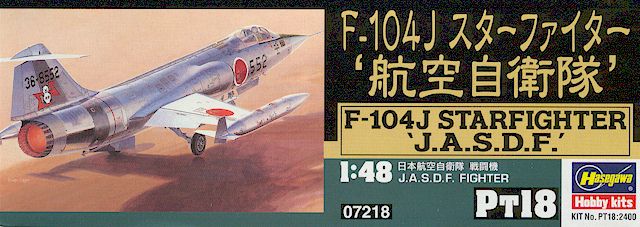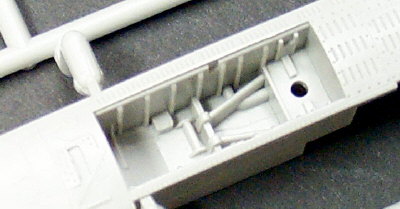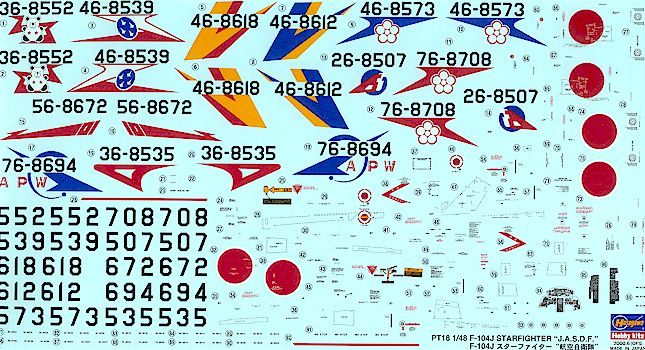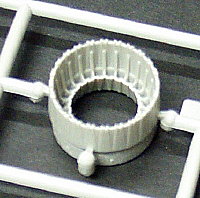|
F-104J Starfighter
Hasegawa

S u m m a r y
|
| Catalogue Number: |
PT18 |
| Scale: |
1/48 |
| Contents and Media: |
117 light grey styrene parts (3 not used); 19 clear
parts (10 not used); and 4 polythene caps (one not used). |
| Price: |
¥ 2400 |
| Review Type: |
FirstLook |
| Advantages: |
State of the art surface texture; comprehensive
details; positionable control surfaces and speed brake; poly-cap undercarriage attachment;
three piece canopy; ten marking options; great value. |
| Disadvantages: |
Japanese versions only; some ejector pin marks;
misleading instructions for optional clear formation lights; poor packing of
main parts in a single bag. |
| Recommendation: |
Highly Recommended |
Reviewed by Brett Green
The Lockheed F-104J is the Japanese version of the Starfighter. The Japanese
Starfighter was substantially similar to the early F-104G. In fact, the first F-104Js were
simply re-assembled F-104Gs.
Hasegawa's first F-104 in 1/48 scale comprises 117 light grey styrene parts (3 not
used); 19 clear parts (10 not used); and 4 poly caps (one not used). All 13 grey
sprues are squeezed into a single plastic bag, risking scratching and scuffing
in transit.
|
 Surface texture is gorgeous, with crisp, fine panel lines, raised covers and fairings
and hundreds of tiny, recessed holes representing the Starfighter's characteristic flush
rivets. Surface texture is gorgeous, with crisp, fine panel lines, raised covers and fairings
and hundreds of tiny, recessed holes representing the Starfighter's characteristic flush
rivets.
Ejector pin marks are mostly confined to the invisible inside surface of kit parts with
a few exceptions. Due to the limitations of the injection moulding process, the one-piece
flaps, ailerons and slats all suffer from shallow pin marks.
|
|
 Detail is outstanding. The wheel wells, speed-brake bay and jet exhaust are all
chock-full of structural detail and plumbing. There will be very little need for
additional
detail in these areas. The cockpit benefits from this high standard too, with a 14 piece
pilot's seat incorporating a (slightly undernourished) harness and very nice fabric
texture. Detail is outstanding. The wheel wells, speed-brake bay and jet exhaust are all
chock-full of structural detail and plumbing. There will be very little need for
additional
detail in these areas. The cockpit benefits from this high standard too, with a 14 piece
pilot's seat incorporating a (slightly undernourished) harness and very nice fabric
texture.
The fuselage breakdown hints at further variants. The two-part nose cone is separate,
and an insert behind the canopy suggests that two-seater Starfighters are on the way. A
three-piece canopy is provided, permitting all that lovely cockpit detail to be displayed.
|
 The wing assembly is designed so that movable surfaces can be positioned. The slats,
flaps and ailerons are all single parts. This is not only handy for personalising your
Starfighter, but also ensures sharp leading and trailing edges on the razor-like flying
surfaces. Slats and flaps have rounded joining surfaces to simplify positioning, while the
ailerons (and rudder) are connected via pins. The pins will have to be removed if these
parts are to be repositioned. The wing assembly is designed so that movable surfaces can be positioned. The slats,
flaps and ailerons are all single parts. This is not only handy for personalising your
Starfighter, but also ensures sharp leading and trailing edges on the razor-like flying
surfaces. Slats and flaps have rounded joining surfaces to simplify positioning, while the
ailerons (and rudder) are connected via pins. The pins will have to be removed if these
parts are to be repositioned.
The undercarriage is another highlight. The main wheels are supplied with a separate
tyre and two-piece wheel hub. Undercarriage legs are secured using poly caps. Both of
these features will make painting and final assembly of this model much simpler.
The large, colourful decal sheet supplies markings for ten JASDF Starfighters in the
same basic scheme of silver fuselage, with grey and white wings.

Instructions are typical Hasegawa fare with construction called out over 18 steps using
extensive diagrams and sporadic descriptions.
There is only one misleading instruction that I have found so far. If you want to
install the optional clear parts for the fuselage and fuel tank formation lights (as called out in Steps
11 and 18), you will have to drill out the holes and install the clear parts FROM THE
INSIDE of the parts in twelve positions BEFORE THE FUSELAGE AND TANKS
ARE ASSEMBLED.
In other words, drill these holes and install the parts before Step 5, Fuselage
Assembly.
It should come as no surprise that Hasegawa's new 1/48 scale F-104J is a beautiful kit.
Its pedigree is long and distinguished. By coincidence, I bought the re-released Hasegawa
1/48 scale F-4J Phantom II kit at the same time as the F-104. The Phantom dates back to
the late 1980s, but still holds up well by today's standards in terms of surface texture,
detail and accuracy. Over a decade later, this Starfighter continues and refines that
tradition.
|
 Hasegawa's F-104J is another example of the potential for plastic in the new
Millenium,
and represents an absolute bargain at 2400 yen. Hasegawa's F-104J is another example of the potential for plastic in the new
Millenium,
and represents an absolute bargain at 2400 yen.
Highly Recommended
|
Review and Image Copyright © 2000 by Brett Green
Page Created 20 June, 2000
Last updated 22 July, 2003
Back to HyperScale Main Page
Back to Reviews Page
|
Home | What's
New | Features
| Gallery |
Reviews | Reference
| Forum
| Search